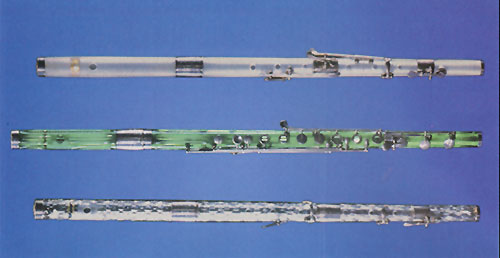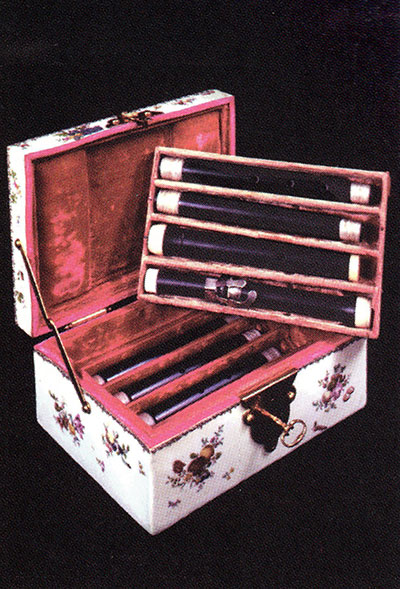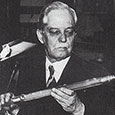
Claude Laurent crystal flutes, Paris. From top: D.C.M. #850, 1811; D.C.M. #11, 1844; D.C.M. #378, gift to President James Madison.
Flutists who visit Washington D.C. should check out the Dayton C. Miller collection in the Madison Building of the Library of Congress. It is the largest flute collection in the world with nearly 1,700 flutes made by over 450 European and American manufacturers and craftsmen. There are also 3,000 books, 10,000 compositions, plus patents and other materials about the flute.
Dayton C. Miller was born on a farm in Strongsville, Ohio in 1866 and became fascinated with his grandfather’s surveying instruments. His interest in scientific and mechanical devices grew into astronomy, and he built three refracting telescopes. Because his father was a fifer in the Civil War and played in a local fifeand-drum corp, Miller became interested in music and learned to play his father’s fife which is part of the Dayton C. Miller collection today, catalogued as D.C.M. #1. On his 13th birthday Miller received a flute made by H.F. Meyer, but his hands were too small to cover the holes, and he used a six-key Meyer system piccolo until he grew. At his graduation cerernomy in 1886 at Baldwin University, Miller performed a flute solo and gave a lecture on "The Sun." Even here his combined interest in music and science was evident.
Miller purchased a silver William Meinell, Boehm-system flute with a wood head that year and earned a doctorate in astronomy from Princeton in 1890. After that he taught astronomy and physics at Case School of Applied Science, now Case Western Reserve University, in Cleveland, Ohio.
In 1908, Miller developed the phonodeik, a device that converted sound waves into visual images that could be used to analyze sound. With this he proved that flute tubes that are made of a dense material will produce better tone than others. He also determined the physical factors in an auditorium that improved or harmed the acoustics. On the basis of this research Miller designed or consulted on the construction of Severance Hall in Cleveland and several other noteworthy concert halls. His continuing interest in music and science led Miller to write the first history of acoustics and several books on instrument waveforms. As Miller acquired more flutes he conducted many experiments on the instruments. Although flutists today think of Miller as a collector, and he certainly was a prolific collector, but he also made a silver E flat flute in 1901 and a one-piece gold flute in 1905. Miller translated Boehm’s Die Flote und das Flotenspiel into English in 1871, and the edition flutists read today is based on a 1922 edition of that translation.
Miller numbered and catalogued each item as it joined his collection. In 1913 he bought ten flutes from the Joseph Fischer estate in Cleveland and added 27 more flutes to the collection in 1917, when the total reached 53. Miller looked through pawn shops, music stores, and estate auctions to find instruments for the collection. Over 90% of the items were added after his 50th birthday in 1917.
Miller approached the Smithsonian Institute when searching for a home for the collection, but was distressed over its intention to divide the collection. The Library of Congress agreed to accept and maintain the collection as a unit. Miller intended to act as curator of the collection, but he died on February 22, 1941, just before the collection was moved from Cleveland to the Library of Congress.

Frederick the Great’s fiute, possibly made by J.J. Quantz in approximately 1750.
About the Collection
Miller catalogued the instruments in five divisions in handwritten ledgers. The 1,500 flutes include clay, bone, bamboo, jade, ivory, silver, crystal, platinum, and gold instruments plus some other wind instruments that date from 1100 B.C. Some are toys or simple folk instruments while others are sophisticated instruments used by professionals. The collection includes 18th- and early 19th-century crystal flutes by Claude Laurent, a flute presented to President James Madison in 1813, several Rudall Carte & Co. flutes, and a Quantz-model traverso once owned and played by King Frederick the Great of Prussia. Many of the 19th- and early 20th-centuries flutes were technical innovations. These include five versions of Cornelius Ward’s patent flute system and an early 20th century Nicholas Alberti patent piccolo, which plays in either C or D flat.
His 3,000 books include Hotteterre’s The Rudiments or Principles of the German Flute, published in 1729. Miller acquired Theobald Boehm’s early manuscript copy. With sculptures, pictures of flutists, and aurographs, the Miller collection continue to grow as others contribute valuable instruments to it.






